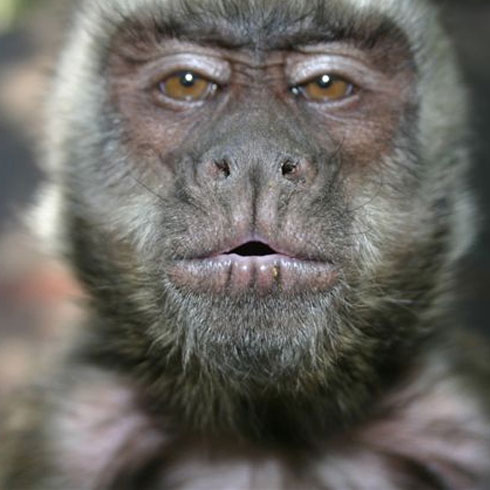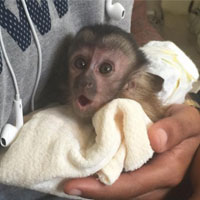
Some trees have a most peculiar effect on those that visit them. The web of life in forests are so complex that we still do not understand all that is going on. But there is one creature enlisted by the trees whose life is so closely entwined that many forest trees would disappear without its cooperation.
Through their role in seed dispersal, spider monkeys have a capacity to help regenerate rainforests. It is believed that some seeds, like dialium, rely on being passed through a spider monkey’s stomach in order to regenerate.
Hanging by long tails from a high branch it is easy to see the black spider shape that's prompted the forest Indians to give the monkey its name. Spider monkeys spend their whole lives high up in the rainforest canopy eating fruit but as with everything it is not that simple. Their prehensile tail is the longest in the world.
By curling the tip of that muscular tail around a branch they have their hands-free - to reach for food or play with one another. Their bodies are covered in thick black fur which may seem odd for an animal that lives in such hot humid climes but the night air in the canopy can be cold, especially when it's raining and like all monkeys, they take great care to keep their coat in good condition.
In the forest, every plant must ensure that at least one or two of its seeds grow to maturity. In order to do so, they have to combat an army of predators.
The Laconia tree attracts the Spider Monkey by producing an irresistible pulp but in this case, the monkey does not swallow the seed as it is much too big for that.It drops the seed to the forest floor, and it is here that another creature will ensure the Laconia trees’ future. The akuti moves through the forest using a special scent gland to mark its route.A dainty wiggle leaves an invisible message that will lead it back to food it found earlier.
It does eat and destroy many seeds but even in this seemingly rich forest, there are times coming soon when life will be a daily struggle to survive. The seed is planted at the perfect place for it to germinate. The akuti covers its tracks well it buries so many that when it eventually returns to dig them up some will already have begun to grow.

After spider monkeys feed on the Latanya fruits their droppings also fall onto the leaf litter below. These contain seeds from other fruits that they've eaten earlier in the day. The droppings are a good source of free fertilizer for the seed but another creature with eccentric dining habits has other intentions. Within minutes of the monkey droppings hitting the ground, horn dung beetles will home in on the smell and will bit-by-bit drag the entire heap into a freshly dug chamber underground where the seeds are buried along with the dung. However, the beetle only feasts on the feces and the seed will remain underground where they have a better chance to germinate away from the jaws of predators.
Many familiar foods originate in the rainforest. Chocolate is made from the seeds of the cocoa tree. Wild cocoa produces fruits in the low forest land. One monkey that cannot resist it is the grey sake, seed predator and number one enemy of many trees. The pod grows directly off the main trunk tree making it easier for some animals to reach
The sakhis teeth are especially. adapted for biting open hard fruit husks they prefer their seeds to be young and fresh. Seed predators such as squirrels and sakhis are as important as the dispersers and the overall strategy of the forest. By limiting the number of germinating seeds from each tree they prevent too many seedlings from competing for limited food and light.
Some trees protect their crop by producing husks strong enough to prevent predators from getting through to the seeds. The tree best known in Amazonia for doing this is the Brazil nut.
The mahogany tree uses the same strategy, but they do not rely upon animals to disperse them. The pods are very tough. It is the wind that will eventually carry their winged seeds away from the parent trees. The Brazil nuts’ 2.5 kg pod falls from a height of about 15 meters and they have been known to kill people. The thud of the husks hitting the floor attracts the only animal really capable of opening it.

The agouti is a timid and cautious creature but there are predators in this forest, other than those that eat seeds, to which a three and a half kilogram agouti would make a good meal. After peeling the soft outer layer, it delicately pairs away the hardwood. But even with its chisel-like teeth, it takes this rodent up to 20 minutes to get through to the 18 or so seeds inside. With its sharp teeth, the agouti shells them easily. After eating one, the agouti will take the seeds inside the husk one-by-one up to a half kilometre away and store them for the hard times that are just around the corner. Like its cousin the Iguchi it will not retrieve all of them and those that remain buried will eventually repopulate this area of the forest with Brazil nut trees.
Spider monkeys have a maximum home range of about a square kilometre. A dominant female heads the small party on their foraging trips through the forest.The babies are born at the beginning of the wet season and will be nursed by their mothers until they are 3 years of age. The youngster won't leave her back permanently until it is a year and a half old. During this time, it learns to feed by example.
Spider monkeys specialize in eating the fruits of many big valuable timber trees. To avoid predation the seeds must germinate quickly and they do not unless the outer layer of the seed has been softened. Only by passing through the spider monkeys digestive system will this happen.
All the fruits that spider monkeys disperse have to be split open with their teeth but some plants employ a very different strategy to attract potential seed dispersers. When their seeds are mature the tree advertises the fact by opening the fruit to reveal appetizing colours, sometimes with a startling effect!
Some birds like a certain species guan are attracted by the edible seed coating but to eat it they also have to swallow the seed. The bird will regurgitate the seed later far away from the parent plant -an important factor if a forest is to remain diverse and healthy.

A bird built to fly a beak is a fair description of the toucan and like the spider monkey, it is a very important seed disperser. The toucan swallows the whole fruit and later, far away from where it was picked, the seed will be regurgitated. The huge beak may look clumsy, but it is actually a precision instrument which allows the bird to delicately pick fruit from the extremities of branches that a smaller beak could not reach.
For hundreds of thousands of years, the animals and forest trees have evolved together. Many are completely reliant upon each other for survival. Today that existence is increasingly fragile. Mankind could benefit from these complex relationships but only if they are allowed to continue.
What miracle drugs are locked within the rainforests of the Amazon?
Maybe the spider monkey has the key
Sources:
Internet Various
Discovery Channel


 Conservation in Southern Africa is rapidly becoming unsustainable without the active involvement of the community, especially the younger, more active generation. The Bushbabies Monkey Sanctuary and The Elephant Sanctuary group strongly believe that we have to get the younger members of communities involved to instill a passion for the environment and wildlife in them through education.
Conservation in Southern Africa is rapidly becoming unsustainable without the active involvement of the community, especially the younger, more active generation. The Bushbabies Monkey Sanctuary and The Elephant Sanctuary group strongly believe that we have to get the younger members of communities involved to instill a passion for the environment and wildlife in them through education. I'll introduce you to Joyce, for example. A young female capuchin, she was rather pampered with child-like paraphernalia; a dress and a small hat around her head. Cute, indeed. She had been with her "foster" family since only two months old, bought straight from a breeder. The couple who owned her did not have children, and so decided to substitute the missing link with a primate, albeit a bit smaller...and with sharper teeth.
I'll introduce you to Joyce, for example. A young female capuchin, she was rather pampered with child-like paraphernalia; a dress and a small hat around her head. Cute, indeed. She had been with her "foster" family since only two months old, bought straight from a breeder. The couple who owned her did not have children, and so decided to substitute the missing link with a primate, albeit a bit smaller...and with sharper teeth.



